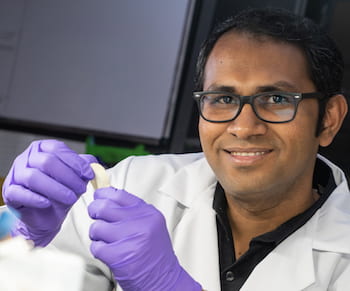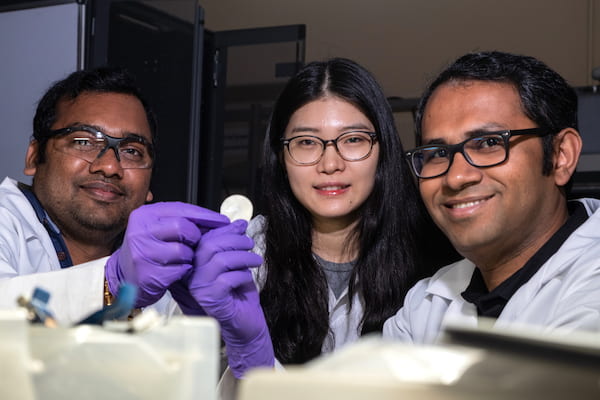NEWS RELEASE
Editor’s note: Links to video and high-resolution images for download appear at the end of this release.
David Ruth
713-348-6327
david@rice.edu
Mike Williams
713-348-6728
mikewilliams@rice.edu
New way to beat the heat in electronics
Rice University lab’s flexible insulator offers high strength and superior thermal conduction
HOUSTON – (May 16, 2019) – A nanocomposite invented at Rice University’s Brown School of Engineering promises to be a superior high-temperature dielectric material for flexible electronics, energy storage and electric devices.

Rice research scientist M.M. Rahman holds a flexible dielectric made of a polymer nanofiber layer and boron nitride. The new material stands up to high temperatures and could be ideal for flexible electronics, energy storage and electric devices where heat is a factor. Photo by Jeff Fitlow
The nanocomposite combines one-dimensional polymer nanofibers and two-dimensional boron nitride nanosheets. The nanofibers reinforce the self-assembling material while the “white graphene” nanosheets provide a thermally conductive network that allows it to withstand the heat that breaks down common dielectrics, the polarized insulators in batteries and other devices that separate positive and negative electrodes.
The discovery by the lab of Rice materials scientist Pulickel Ajayan is detailed in Advanced Functional Materials.
Research scientist M.M. Rahman and postdoctoral researcher Anand Puthirath of the Ajayan lab led the study to meet the challenge posed by next-generation electronics: Dielectrics must be thin, tough, flexible and able to withstand harsh environments.
“Ceramic is a very good dielectric, but it is mechanically brittle,” Rahman said of the common material. “On the other hand, polymer is a good dielectric with good mechanical properties, but its thermal tolerance is very low.”
Boron nitride is an electrical insulator, but happily disperses heat, he said. “When we combined the polymer nanofiber with boron nitride, we got a material that’s mechanically exceptional, and thermally and chemically very stable,” Rahman said.
A lab video shows how quickly heat disperses from a composite of a polymer nanoscale fiber layer and boron nitride nanosheets. When exposed to light, both materials heat up, but the plain polymer nanofiber layer on the left retains the heat far longer than the composite at right. Courtesy of the Ajayan Research Group
The 12-to-15-micron-thick material acts as an effective heat sink up to 250 degrees Celsius (482 degrees Fahrenheit), according to the researchers. Tests showed the polymer nanofibers-boron nitride combination dispersed heat four times better than the polymer alone.
In its simplest form, a single layer of polyaramid nanofibers binds via van der Waals forces to a sprinkling of boron nitride flakes, 10% by weight of the final product. The flakes are just dense enough to form a heat-dissipating network that still allows the composite to retain its flexibility, and even foldability, while maintaining its robustness. Layering polyaramid and boron nitride can make the material thicker while still retaining flexibility, according to the researchers.
“The 1D polyaramid nanofiber has many interesting properties except thermal conductivity,” Rahman said. “And boron nitride is a very interesting 2D material right now. They both have different independent properties, but when they are together, they make something very unique.”
Rahman said the material is scalable and should be easy to incorporate into manufacturing.

From left, postdoctoral researcher Anand Puthirath, academic visitor Fanshu Yuan and research scientist M.M. Rahman show the high-temperature flexible dielectric material invented at Rice University. The three are among authors of a paper in Advanced Functional Materials that details the work. Photo by Jeff Fitlow
Co-authors of the paper are Rice academic visitors Aparna Adumbumkulath and Fanshu Yuan, alumnus Thierry Tsafack, graduate students Morgan Barnes, Zixing Wang, Sandhya Susarla, Seyed Mohammad Sajadi, Devashish Salpekar and Hossein Robatjazi, research scientist Ganguli Babu and Rafael Verduzco, an associate professor of chemical and biomolecular engineering and of materials science and nanoengineering; Sampath Kommandur and Shannon Yee of the Georgia Institute of Technology; and Kazuki Nomoto, S.M. Islam and Huili Xing of Cornell University. Ajayan is chair of Rice’s Department of Materials Science and NanoEngineering, the Benjamin M. and Mary Greenwood Anderson Professor in Engineering and a professor of chemistry.
The Army Research Laboratory funded the research.
-30-
Read the abstract at https://onlinelibrary.wiley.com/doi/10.1002/adfm.201900056.
Follow Rice News and Media Relations via Twitter @RiceUNews.
Video:
A lab video shows how quickly heat disperses from a composite of a polymer nanoscale fiber layer and boron nitride nanosheets. When exposed to light, both materials heat up, but the plain polymer nanofiber layer on the left retains the heat far longer than the composite at right. (Credit: Ajayan Research Group/Rice University)
Images for download:
https://news2.rice.edu/files/2019/05/0520_DIELECTRIC-1-web.jpg
Rice University research scientist M.M. Rahman holds a flexible dielectric made of a polymer nanofiber layer and boron nitride. The new material stands up to high temperatures and could be ideal for flexible electronics, energy storage and electric devices where heat is a factor. (Credit: Jeff Fitlow/Rice University)
https://news2.rice.edu/files/2019/05/0520_DIELECTRIC-2-web-4.jpg
From left, postdoctoral researcher Anand Puthirath, academic visitor Fanshu Yuan and research scientist M.M. Rahman show the high-temperature flexible dielectric material invented at Rice University. The three are among authors of a paper in Advanced Functional Materials that details the work. (Credit: Jeff Fitlow/Rice University)
Related materials:
Ajayan Research Group: https://ajayan.rice.edu
Rice Materials Science and NanoEngineering: https://msne.rice.edu
Brown School of Engineering: https://engineering.rice.edu
Located on a 300-acre forested campus in Houston, Rice University is consistently ranked among the nation’s top 20 universities by U.S. News & World Report. Rice has highly respected schools of Architecture, Business, Continuing Studies, Engineering, Humanities, Music, Natural Sciences and Social Sciences and is home to the Baker Institute for Public Policy. With 3,962 undergraduates and 3,027 graduate students, Rice’s undergraduate student-to-faculty ratio is just under 6-to-1. Its residential college system builds close-knit communities and lifelong friendships, just one reason why Rice is ranked No. 1 for lots of race/class interaction and No. 2 for quality of life by the Princeton Review. Rice is also rated as a best value among private universities by Kiplinger’s Personal Finance.




